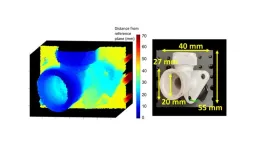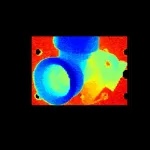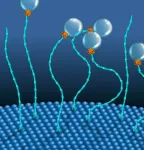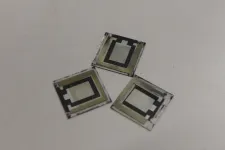(Press-News.org) WASHINGTON — For the first time, researchers have demonstrated a prototype lidar system that uses quantum detection technology to acquire 3D images while submerged underwater. The high sensitivity of this system could allow it to capture detailed information even in extremely low-light conditions found underwater.
“This technology could be useful for a wide range of applications,” said research team member Aurora Maccarone, a Royal Academy of Engineering research fellow from Heriot-Watt University in the United Kingdom. “For example, it could be used to inspect underwater installations, such as underwater wind farm cables and the submerged structure of the turbines. Underwater lidar can also be used for monitoring or surveying submerged archaeology sites and for security and defense applications.”
Obtaining 3D images through ocean water can be challenging because it is light-limited, and any particles in the water will scatter light and distort the image. However, single-photon detection, which is a quantum-based technique, allows very high penetration and works even in low-light conditions.
In the Optica Publishing Group journal Optics Express, researchers from Heriot-Watt University and the University of Edinburgh describe experiments in which an entire single-photon lidar system was submerged in a large water tank. The new demonstrations bring the technology closer to practical applications compared to the research team’s earlier experiments with underwater single-photon detection, which were performed in carefully controlled laboratory conditions with the optical setup placed outside the water tank and data analysis performed offline. They also implemented new hardware and software developments that allow the 3D images acquired by the system to be reconstructed in real time.
“This work aims to make quantum detection technologies available for underwater applications, which means that we will be able to image the scene of interest in very low light conditions,” said Maccarone. “This will impact the use of offshore cable and energy installations, which are used by everyone. This technology could also allow monitoring without the presence of humans, which would mean less pollution and a less invasive presence in the marine environment.”
Faster low-light detection
Lidar systems create images by measuring how long it takes laser light to be reflected from objects in the scene and travel back to the system’s receiver, known as the “time of flight.” In the new work, the researchers sought to develop a way to acquire 3D images of targets that are obscured by turbid water and thus not visible to conventional lidar imaging systems.
They designed a lidar system that uses a green pulsed laser source to illuminate the scene of interest. The reflected pulsed illumination is detected by an array of single-photon detectors, which allows ultrafast low light detection and greatly reduces measurement time in photon-starved environments such as highly attenuating water.
“By taking time-of-flight measurements with picosecond timing resolution, we can routinely resolve millimeter details of the targets in the scene,” said Maccarone. “Our approach also allows us to distinguish the photons reflected by the target from those reflected by particles in the water, making it particularly suitable to performing 3D imaging in highly turbid waters where optical scattering can ruin image contrast and resolution.”
The fact that this approach requires thousands of single-photon detectors, all producing many hundreds of events per second, makes it extremely challenging to retrieve and process the data necessary to reconstruct the 3D image in a short time, especially for real-time applications. To solve this problem, the researchers developed algorithms specifically for imaging in highly scattering conditions and applied them in conjunction with widely available graphics processing unit (GPU) hardware.
The new technique builds on some important technological advances. “Heriot-Watt University has a long track record in single‑photon detection techniques and image processing of single-photon data, which allowed us to demonstrate advanced single‑photon imaging in extremely challenging conditions,” said Maccarone. “The University of Edinburgh has achieved fundamental advances in the design and fabrication of single-photon avalanche diode detector arrays, which allowed us to build compact and robust imaging systems based on quantum detection technologies.”
Underwater testing
After optimizing the optical setup on a laboratory optical bench, the researchers connected the lidar system to a GPU to achieve real-time processing of the data while also implementing a number of image processing approaches for three-dimensional imaging. Once the system was working properly, they moved it to a tank that was 4 meters long, 3 meters wide, and 2 meters deep.
With the system submerged in the water, the researchers added a scattering agent in a controlled manner to make the water more turbid. Experiments at three different turbidity levels demonstrated successful imaging in controlled highly scattering scenarios at distances of 3 meters.
“Single-photon technologies are rapidly developing, and we have demonstrated very promising results in underwater environments,” said Maccarone. “The approach and image processing algorithms could also be used in a wider range of scenarios for improved vision in free space such as in fog, smoke or other obscurants.”
The researchers are now working to reduce the size of the system so that it could be integrated into an underwater vehicle. Through the UK Quantum Technology Hub Network and InnovateUK, the researchers are partnering with industry to make the technology accessible for a range of underwater applications.
Paper: A. Maccarone, K. Drummond, A. McCarthy, U. K. Steinlehner, J. Tachella, D. A. Garcia, A. Pawlikowska, R. A. Lamb, R. K. Henderson, S. McLaughlin, Y. Altmann, G. S. Buller, “Submerged single-photon LiDAR imaging sensor used for real-time 3D scene reconstruction in scattering underwater environments,” Opt. Express Vol. 31, Issue 10, pp. 16690-16708 (2023).
DOI: doi.org/10.1364/OE.487129
About Optics Express
Optics Express reports on scientific and technology innovations in all aspects of optics and photonics. The bi-weekly journal provides rapid publication of original, peer-reviewed papers. It is published by The Optical Society (OSA) and led by Editor-in-Chief James Leger of the University of Minnesota, USA. Optics Express is an open-access journal and is available at no cost to readers online at OSA Publishing.
About Optica Publishing Group (formerly OSA)
Optica Publishing Group is a division of Optica (formerly OSA), Advancing Optics and Photonics Worldwide. It publishes the largest collection of peer-reviewed content in optics and photonics, including 18 prestigious journals, the society’s flagship member magazine, and papers from more than 835 conferences, including 6,500+ associated videos. With over 400,000 journal articles, conference papers and videos to search, discover and access, Optica Publishing Group represents the full range of research in the field from around the globe.
END
Quantum lidar prototype acquires real-time 3D images while fully submerged underwater
Highly sensitive imaging approach could allow monitoring or surveillance in turbid water
2023-05-04
ELSE PRESS RELEASES FROM THIS DATE:
American Geriatrics Society welcomes Donna M. Fick, PhD, GCNS-BC, AGSF, FGSA, FAAN As New President At 2023 Annual Scientific Meeting
2023-05-04
New York (May 3, 2022) — Donna M. Fick, PhD, GCNS-BC, AGSF, FGSA, FAAN will step into the role of President of the American Geriatrics Society (AGS) at the 2023 AGS Annual Scientific meeting which is taking place May 4-6, 2023 (pre-conference day is May 3). An AGS member since 1999 and a member of its Board since 2015, Dr. Fick is committed to working with AGS leaders and members to improve the health, independence, and quality of life of all older people.
“I have always appreciated AGS’ focus, support and advancement of an interprofessional team approach that puts older adults and caregivers at the center, embraces the best evidence ...
Investment in Ontario drug discovery research will help develop new cancer medicines for patients
2023-05-04
May 4, 2023, TORONTO – Ontario research teams investigating new ways to treat cancer are taking the crucial next steps to bring their discoveries to patients thanks to support from the Ontario Institute for Cancer Research (OICR).
OICR announced it is funding five Ontario-based drug discovery projects between $150,000 and $300,000 per project through its Cancer Therapeutics Innovation Pipeline (CTIP) initiative. CTIP supports research into promising molecules that could become the next generation of cancer therapeutics.
This year’s cohort of CTIP projects aims to develop treatments for some of the most devastating cancers, including pancreatic cancer, ovarian cancer, breast cancer ...
Machine learning can support urban planning for energy use
2023-05-04
As Philadelphia strives to meet greenhouse gas emissions goals established in its 2050 Plan, a better understanding of how zoning can play a role in managing building energy use could set the city up for success. Researchers in Drexel University’s College of Engineering are hoping a machine learning model they’ve developed can support these efforts by helping to predict how energy consumption will change as neighborhoods evolve.
In 2017, the city set a goal of becoming carbon neutral by 2050, led in large part by a reduction in greenhouse gas emissions from building energy use – which ...
University of Toronto researchers use generative AI to design novel proteins
2023-05-04
Researchers at the University of Toronto have developed an artificial intelligence system that can create proteins not found in nature using generative diffusion, the same technology behind popular image-creation platforms such as DALL-E and Midjourney.
The system will help advance the field of generative biology, which promises to speed drug development by making the design and testing of entirely new therapeutic proteins more efficient and flexible.
“Our model learns from image representations to generate fully new proteins, at a very high rate,” says Philip ...
St. Jude tool gets more out of multi-omics data
2023-05-04
(MEMPHIS, Tenn. – May 04, 2023) Despite the astounding advances made in understanding the biologic underpinnings of cancer, many cancers are missing obvious genetic drivers. When scientists can’t pinpoint the factors that drive cancer, treating it can be much more difficult. Scientists at St. Jude Children’s Research Hospital hope to solve that problem with an updated way to analyze multi-omic (primarily transcriptomics and proteomics) data. The researchers created a next-generation computational tool to gain new insights from biological data ...
Alternative fuel for string-shaped motors in cells
2023-05-04
Cells have a fascinating feature to neatly organize their interior by using tiny protein machines called molecular motors that generate directed movements. Most of them use a common type of fuel, a kind of chemical energy, called ATP to operate. Now researchers from the Max Planck Institute of Molecular Cell Biology and Genetics (MPI-CBG), the Cluster of Excellence Physics of Life (PoL) and the Biotechnology Center (BIOTEC) of the TU Dresden in Dresden, Germany, and the National Centre for Biological Sciences (NCBS) in Bangalore, India, discovered a novel molecular system that uses an alternative chemical energy and employs a novel mechanism ...
How seaweed has been misleading scientists about reef health
2023-05-04
For decades, scientists have looked to seaweed as an indicator of the health of coral reefs lying underneath.
But what if the seaweed was misleading them?
New UBC research reveals it was, and scientists need new ways to determine whether human activity is harming a particular reef.
"This is especially critical today, given that reefs globally are threatened by climate-driven stressors,” said Dr. Sara Cannon, a postdoctoral fellow at the UBC Institute for the Oceans and Fisheries and the study's lead author.
Local species ...
CityU researchers develop an additive to efficiently improve the efficiency and stability of perovskite solar cells
2023-05-04
Perovskite solar cells (PVSCs) are a promising alternative to traditional silicon-based solar cells because of their high power-conversion efficiency and low cost. However, one of the major challenges in their development has been achieving long-term stability. Recently, a research team from City University of Hong Kong (CityU) made a breakthrough by developing an innovative multifunctional and non-volatile additive which can improve the efficiency and stability of perovskite solar cells by modulating perovskite film growth. This simple and effective strategy has great potential for facilitating the commercialisation of PVSCs.
“This type of multifunctional ...
Research reveals longstanding cultural continuity at oldest occupied site in West Africa
2023-05-04
Evidence from West Africa about human evolution remains scarce, but recent research has indicated unique patterns of cultural change in comparison to other regions of the continent. A new article in the journal Nature Ecology and Evolution adds to our understanding with a study of the oldest directly dated archaeological site in West Africa. The site shows technological continuity spanning roughly 140,000 years and offers insights into the ecological stability of the region.
Our species emerged in Africa around 300 thousand years ago and ...
A simple antibacterial treatment solves a severe skin problem caused by radiation therapy
2023-05-04
BRONX, NY—May 4, 2023—Acute radiation dermatitis (ARD)—characterized by red, sore, itchy or peeling skin—affects up to 95% of people undergoing radiation treatment for cancer. Severe cases can cause significant swelling and painful skin ulcers that can severely impair quality of life, yet little is known about why this condition occurs and no standardized treatments for preventing severe ARD have been widely adapted.
Researchers at Montefiore Einstein Cancer Center (MECC) have found that many cases of ARD involve a common skin bacterium and that a simple, low-cost treatment ...
LAST 30 PRESS RELEASES:
Scalable and healable gradient textiles for multi‑scenario radiative cooling via bicomponent blow spinning
Research shows informed traders never let a good climate crisis go to waste
Intelligent XGBoost framework enhances asphalt pavement skid resistance assessment
Dual-function biomaterials for postoperative osteosarcoma: Tumor suppression and bone regeneration
New framework reveals where transport emissions concentrate in Singapore
NTP-enhanced lattice oxygen activation in Ce-Co catalysts for low-temperature soot combustion
Synergistic interface engineering in Cu-Zn-Ce catalysts for efficient CO2 hydrogenation to methanol
COVID-19 leaves a lasting mark on the human brain
Scientists use ultrasound to soften and treat cancer tumors without damaging healthy tissue
Community swimming program for Black youth boosts skills, sense of belonging, study finds
Specific depressive symptoms in midlife linked to increased dementia risk
An ‘illuminating’ design sheds light on cholesterol
Who is more likely to get long COVID?
Study showcases resilience and rapid growth of “living rocks”
Naval Research Lab diver earns Office of Naval Research 2025 Sailor of the Year
New Mayo-led study establishes practical definition for rapidly progressive dementia
Fossil fuel industry’s “climate false solutions” reinforce its power and aggravate environmental injustice
Researchers reveal bias in a widely used measure of algorithm performance
Alcohol causes cancer. A study from IOCB Prague confirms damage to DNA and shows how cells defend against it
Hidden viruses in wastewater treatment may shape public health risks, study finds
Unlock the power of nature: how biomass can transform climate mitigation
Biochar reshapes hidden soil microbes that capture carbon dioxide in farmland
Reducing saturated fat intake shows mortality benefit, but only in high-risk individuals
Manta rays create mobile ecosystems, study finds
Study: Mixed results in using lipoic acid to treat progressive multiple sclerosis
Norbert Holtkamp appointed director of Fermi National Accelerator Laboratory
New agentic AI platform accelerates advanced optics design
Biologists discover neurons use physical signals — not electricity — to stabilize communication
Researchers discover that a hormone can access the brain by hitchhiking
University of Oklahoma researcher awarded funding to pursue AI-powered material design
[Press-News.org] Quantum lidar prototype acquires real-time 3D images while fully submerged underwaterHighly sensitive imaging approach could allow monitoring or surveillance in turbid water







